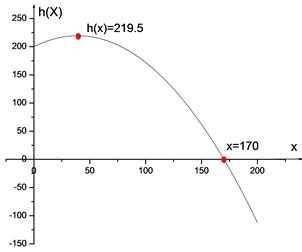
(a)
To find: the horizontal distance from the face of the cliff
(a)
Answer to Problem 11AYU
Therefore, the height of the projectile will be the maximum at a horizontal distance of
Explanation of Solution
Given:
Calculation:
Simplify the function for the height of the projectile.
Compare
Since
Thus,
Therefore, the height of the projectile will be the maximum at a horizontal distance of
Conclusion:
Therefore, the height of the projectile will be the maximum at a horizontal distance of
(b)
To find: the maximum height of the projectile.
(b)
Answer to Problem 11AYU
Therefore, the maximum height of the projectile is
Explanation of Solution
Calculation:
Substitute
Simplify by multiplying the numerator and the denominator by the least common multiple of the denominators, 32
Therefore, the maximum height of the projectile is
Conclusion:
Therefore, the maximum height of the projectile is
(c)
To find:horizontal distancethat the projectile will strike the water
(c)
Answer to Problem 11AYU
Therefore, the projectile will strike the water at a horizontal distance of
Explanation of Solution
Calculation:
When the projectile strikes the water, the height will be 0 .
Thus,
The equation is in the form of the standard quadratic equation.
Find
Find the value of
Since the distance cannot be negative, discard -91.8
Therefore, the projectile will strike the water at a horizontal distance of
Conclusion:
Therefore, the projectile will strike the water at a horizontal distance of
(d)
To graph: graph the function by using a graphing utility
(d)
Answer to Problem 11AYU

Explanation of Solution
Calculation:
Following is the graph of the function

Conclusion:
Thus, the required graph is drawn.
(e)
To verify: the solutions found in parts (b) and (c).
(e)
Answer to Problem 11AYU
From the graph also the maximum height of the projectile is
Explanation of Solution
Calculation:
Following is the graph of the function

From the graph also the maximum height of the projectile is
Conclusion:
From the graph also the maximum height of the projectile is
(f)
To find:the distance of the projectile from the cliff
(f)
Answer to Problem 11AYU
Therefore, when the height of the projectile is
Explanation of Solution
Calculation:
Substitute
Swap the sides of the equation.
Subtract 100 from both the sides.
Compare the equation with the standard form of the quadratic equation.
Find
Find the value of
or -57.57
Since the distance cannot be negative, discard -57.57
Therefore, when the height of the projectile is
Conclusion:
Therefore, when the height of the projectile is
Chapter 3 Solutions
Precalculus
Additional Math Textbook Solutions
A First Course in Probability (10th Edition)
A Problem Solving Approach To Mathematics For Elementary School Teachers (13th Edition)
Introductory Statistics
Calculus for Business, Economics, Life Sciences, and Social Sciences (14th Edition)
Pre-Algebra Student Edition
- Let the region R be the area enclosed by the function f(x)= = 3x² and g(x) = 4x. If the region R is the base of a solid such that each cross section perpendicular to the x-axis is an isosceles right triangle with a leg in the region R, find the volume of the solid. You may use a calculator and round to the nearest thousandth. y 11 10 9 00 8 7 9 5 4 3 2 1 -1 -1 x 1 2arrow_forwardLet the region R be the area enclosed by the function f(x) = ex — 1, the horizontal line y = -4 and the vertical lines x = 0 and x = 3. Find the volume of the solid generated when the region R is revolved about the line y = -4. You may use a calculator and round to the nearest thousandth. 20 15 10 5 y I I I | I + -1.5 -1 -0.5 0.5 1 1.5 2 2.5 3 -5 I -10 -15 I + I I T I I + -20 I + -25 I I I -30 I 3.5 4 xarrow_forwardplease show all the workarrow_forward
 Calculus: Early TranscendentalsCalculusISBN:9781285741550Author:James StewartPublisher:Cengage Learning
Calculus: Early TranscendentalsCalculusISBN:9781285741550Author:James StewartPublisher:Cengage Learning Thomas' Calculus (14th Edition)CalculusISBN:9780134438986Author:Joel R. Hass, Christopher E. Heil, Maurice D. WeirPublisher:PEARSON
Thomas' Calculus (14th Edition)CalculusISBN:9780134438986Author:Joel R. Hass, Christopher E. Heil, Maurice D. WeirPublisher:PEARSON Calculus: Early Transcendentals (3rd Edition)CalculusISBN:9780134763644Author:William L. Briggs, Lyle Cochran, Bernard Gillett, Eric SchulzPublisher:PEARSON
Calculus: Early Transcendentals (3rd Edition)CalculusISBN:9780134763644Author:William L. Briggs, Lyle Cochran, Bernard Gillett, Eric SchulzPublisher:PEARSON Calculus: Early TranscendentalsCalculusISBN:9781319050740Author:Jon Rogawski, Colin Adams, Robert FranzosaPublisher:W. H. Freeman
Calculus: Early TranscendentalsCalculusISBN:9781319050740Author:Jon Rogawski, Colin Adams, Robert FranzosaPublisher:W. H. Freeman
 Calculus: Early Transcendental FunctionsCalculusISBN:9781337552516Author:Ron Larson, Bruce H. EdwardsPublisher:Cengage Learning
Calculus: Early Transcendental FunctionsCalculusISBN:9781337552516Author:Ron Larson, Bruce H. EdwardsPublisher:Cengage Learning





